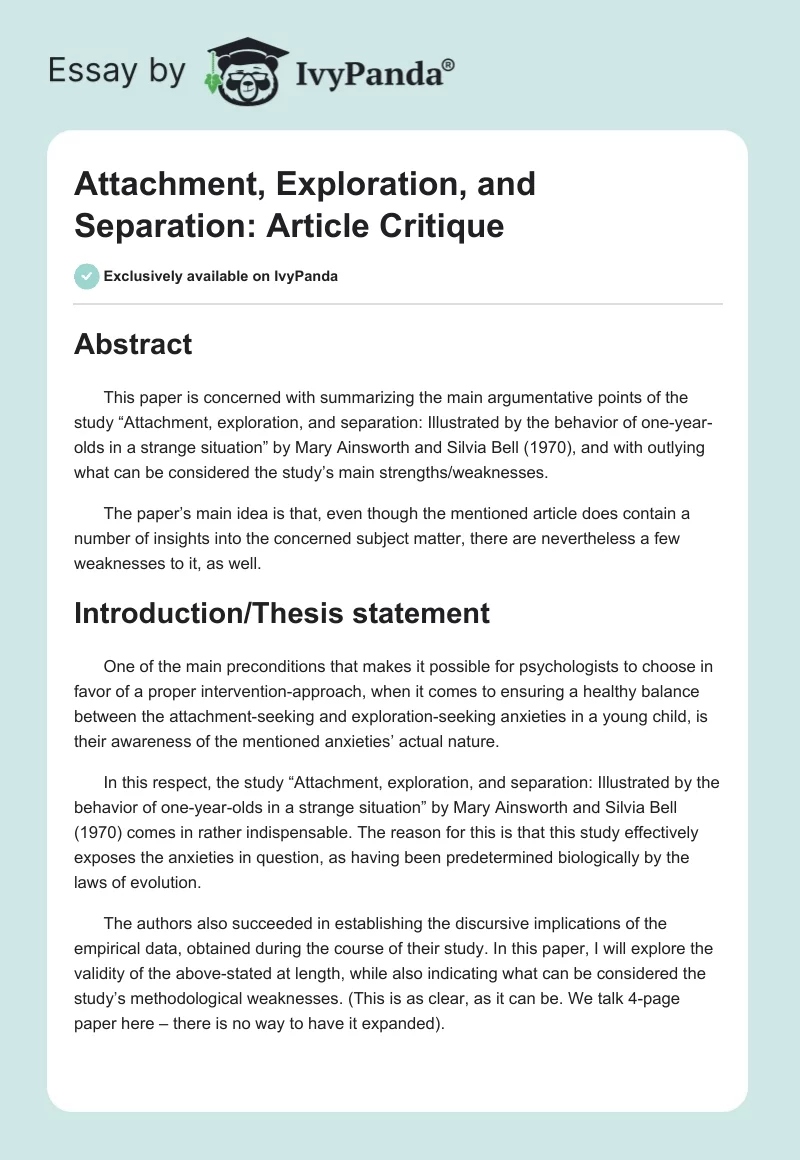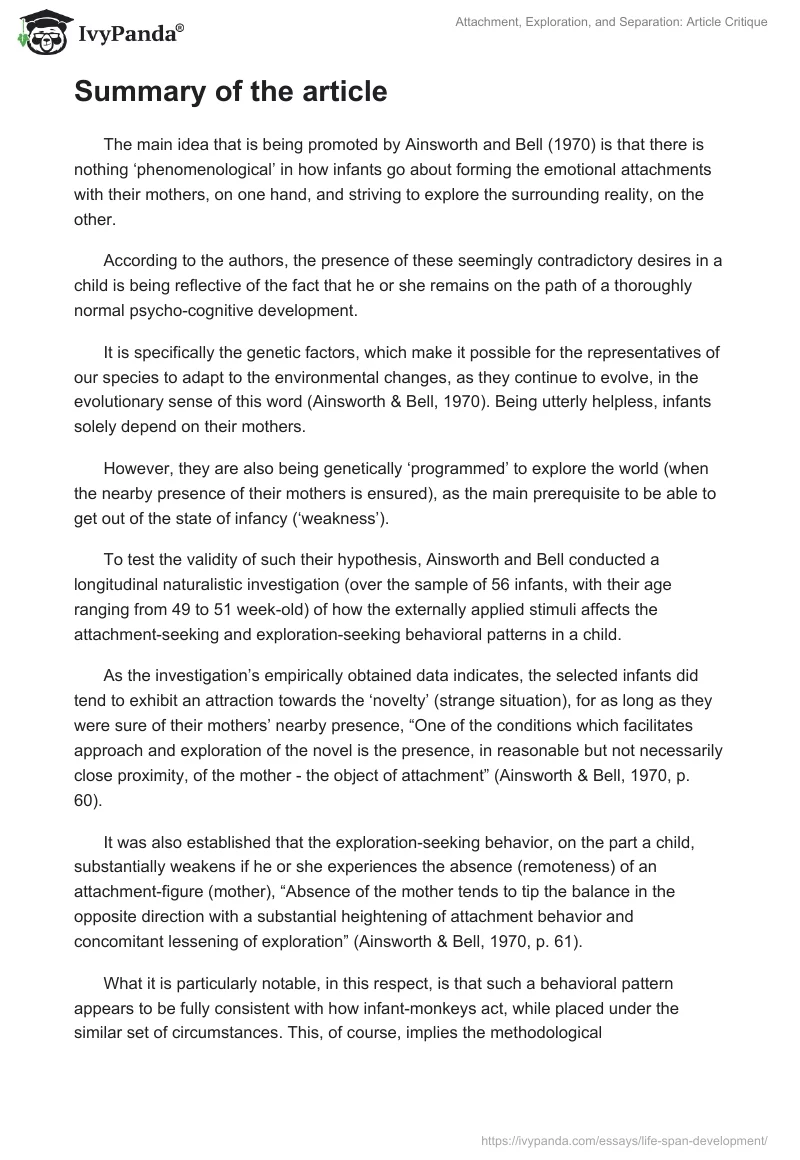Abstract
This paper is concerned with summarizing the main argumentative points of the study “Attachment, exploration, and separation: Illustrated by the behavior of one-year-olds in a strange situation” by Mary Ainsworth and Silvia Bell (1970), and with outlying what can be considered the study’s main strengths/weaknesses.
The paper’s main idea is that, even though the mentioned article does contain a number of insights into the concerned subject matter, there are nevertheless a few weaknesses to it, as well.
Introduction/Thesis statement
One of the main preconditions that makes it possible for psychologists to choose in favor of a proper intervention-approach, when it comes to ensuring a healthy balance between the attachment-seeking and exploration-seeking anxieties in a young child, is their awareness of the mentioned anxieties’ actual nature.
In this respect, the study “Attachment, exploration, and separation: Illustrated by the behavior of one-year-olds in a strange situation” by Mary Ainsworth and Silvia Bell (1970) comes in rather indispensable. The reason for this is that this study effectively exposes the anxieties in question, as having been predetermined biologically by the laws of evolution.
The authors also succeeded in establishing the discursive implications of the empirical data, obtained during the course of their study. In this paper, I will explore the validity of the above-stated at length, while also indicating what can be considered the study’s methodological weaknesses. (This is as clear, as it can be. We talk 4-page paper here – there is no way to have it expanded).
Summary of the article
The main idea that is being promoted by Ainsworth and Bell (1970) is that there is nothing ‘phenomenological’ in how infants go about forming the emotional attachments with their mothers, on one hand, and striving to explore the surrounding reality, on the other.
According to the authors, the presence of these seemingly contradictory desires in a child is being reflective of the fact that he or she remains on the path of a thoroughly normal psycho-cognitive development.
It is specifically the genetic factors, which make it possible for the representatives of our species to adapt to the environmental changes, as they continue to evolve, in the evolutionary sense of this word (Ainsworth & Bell, 1970). Being utterly helpless, infants solely depend on their mothers.
However, they are also being genetically ‘programmed’ to explore the world (when the nearby presence of their mothers is ensured), as the main prerequisite to be able to get out of the state of infancy (‘weakness’).
To test the validity of such their hypothesis, Ainsworth and Bell conducted a longitudinal naturalistic investigation (over the sample of 56 infants, with their age ranging from 49 to 51 week-old) of how the externally applied stimuli affects the attachment-seeking and exploration-seeking behavioral patterns in a child.
As the investigation’s empirically obtained data indicates, the selected infants did tend to exhibit an attraction towards the ‘novelty’ (strange situation), for as long as they were sure of their mothers’ nearby presence, “One of the conditions which facilitates approach and exploration of the novel is the presence, in reasonable but not necessarily close proximity, of the mother – the object of attachment” (Ainsworth & Bell, 1970, p. 60).
It was also established that the exploration-seeking behavior, on the part a child, substantially weakens if he or she experiences the absence (remoteness) of an attachment-figure (mother), “Absence of the mother tends to tip the balance in the opposite direction with a substantial heightening of attachment behavior and concomitant lessening of exploration” (Ainsworth & Bell, 1970, p. 61).
What it is particularly notable, in this respect, is that such a behavioral pattern appears to be fully consistent with how infant-monkeys act, while placed under the similar set of circumstances. This, of course, implies the methodological appropriateness of the positivist method of making inquiries into what accounts for the mechanics of the young child’s behavior.
In addition, it suggests that the would-be-applied intervention strategies (concerned with adjusting the child’s act to be emotionally balanced) can never cease being observant of the fact that, in order for us to be able to understand one’s reactions to the externally applied stimuli, we need to have a clear vision of what may account for these reactions’ evolutionary function. (It is unclear from the comment what the professor implies).
Critique of the article
There can be only a few doubts that the study in question does represent a great value, as such that contains a number of insights into what causes small children to behave in one way or another, while facing the strange.
Probably the main insight, in this respect, is concerned with the fact that, as the study indicates, in order for infants to be able to ensure their ‘evolutionary fitness’, they must be provided with the opportunity to enjoy the company of what happened to be their ‘attachment figures’ (mothers).
After all, the concerned study does show that the notions of ‘attachment’ and ‘exploration’ (in regards to the behavioral patterns in a child), do organically derive out of each other.
The implication of this is quite clear – it represents the matter of a crucial importance to ensure that small infants are able to form an emotional attachment with their parents (specifically, mothers) early in life. The reason for this is that without ‘attachment’, there can be no ‘exploration’, and consequently – no thoroughly normal psycho-cognitive development, on the part of a young child.
What I also find utterly valuable about the study in question, is that it promotes the idea that, in order for psychologists to be able to gain an in-depth understanding of the workings of one’s psyche, they must be willing to refer to the representatives of Homo Sapiens species, as to what they really are – namely, ‘hairless apes’.
Even though this particular implication of the concerned study may appear somewhat ‘unethical’, it does not make it less discursively legitimate. (In the sense of how it relates to the currently dominant socio-cultural discourse of post-modernity).
Nevertheless, there are also a few drawbacks to the study in question. The main of them appears to be the fact that the sample of 56 infants (who participated in the experiment) can hardly be considered thoroughly cross-sectional (in the sociological sense of this word) – especially, if we take into consideration that all of them happened to be White.
This, of course, undermines the would-be universal applicability of the study’s conclusions.
What also undermines the study’s scientific legitimacy is that, methodologically speaking, it is unnecessary complex.
Obviously enough, the authors tried a little too hard striving to ensure the scientific soundness of the investigated subject matter – hence, the hardly understandable formulas/graphs, contained in the study. (I do not deny the appropriateness of graphs; I simply suggest that the empirical phase of the research could have been more efficient).
Even though Ainsworth and Bell do deserve to be given a credit, on the account of attempting to ensure the study’s methodological integrity, the researched matter’s qualitative nature suggests that they would be better off having refrained from adopting such an approach.
After all, the investigation’s empirically obtained data is far from being considered counterintuitive. Quite on the contrary – it correlates rather well with what one’s commonsense logic tells about the mechanics of how a child reacts to the ‘strange’. We do not talk nuclear physics here.
Conclusion
I believe that that the deployed line of argumentation, in regards to what appears to be the reviewed study’s discursive significance, is thoroughly consistent with the paper’s initially provided thesis. (As I mentioned earlier, due to what was the paper’s page-wise format, I was simply in no position to provide an extended conclusion).
Reference
Ainsworth, M.S., & Bell, S.M. (1970). Attachment, exploration, and separation: Illustrated by the behavior of one-year olds in a strange situation. Child Development, 41(1), 49-67.


